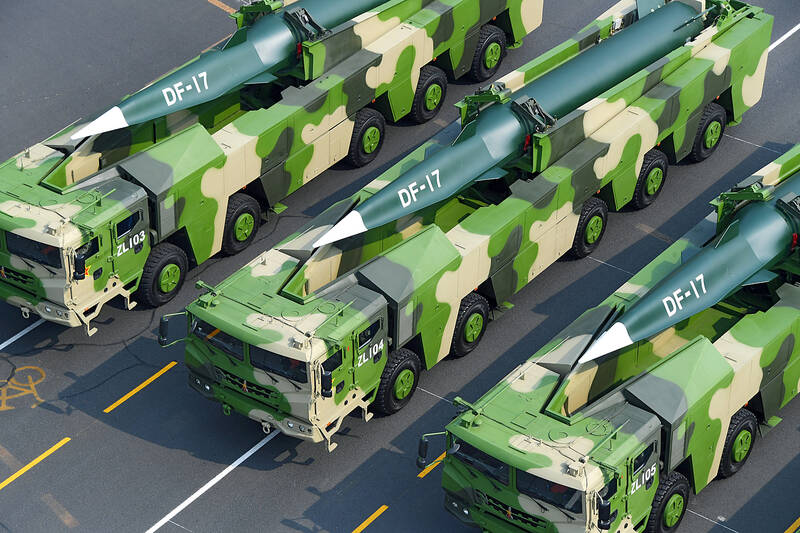China’s plan to deploy a new hypersonic ballistic missile at a Chinese People’s Liberation Army Rocket Force (PLARF) base near Taiwan likely targets US airbases and ships in the western Pacific, but it would also present new threats to Taiwan, defense experts said.
The New York Times — citing a US Department of Defense report from last year on China’s military power — on Monday reported in an article titled “The missiles threatening Taiwan” that China has stockpiled 3,500 missiles, 1.5 times more than four years earlier.
Although it is unclear how many of those missiles were targeting Taiwan, the newspaper reported that the PLARF Brigade 616 base in Jiangxi Province has undergone rapid expansion since 2020 and is being prepared to accommodate Dongfeng-17 (DF-17) hypersonic ballistic missiles.

Photo: EPA-EFE / Xinhua News Agency
It cited sources including Derrek Eveleth, a researcher at the Washington-based Center for Naval Analyses think tank.
Taiwanese media asked Eric Heginbotham, a principal research scientist at the Massachusetts Institute of Technology’s Security Studies Program, to comment on the newspaper report.
China’s hypersonic missiles, including the DF-17, are relatively long-range and therefore likely not designed to hit targets in Taiwan, Heginbotham said.
“If they have the range ascribed to them in the open-source literature, then using them against Taiwan would be a suboptimal use of resources,” he said.
The missiles are more likely to be deployed against US vessels coming to Taiwan’s aid or air bases in the western Pacific were Taiwan and China to go to war, he said.
“To say that it is not designed or optimized to hit targets on Taiwan is not to say that it would never be used against Taiwan, regardless of circumstances,” he added.
For example, if the US did not intervene or China was running low on other types of missiles, it might use the DF-17 against Taiwan, he said, citing Russia’s use of Zircon missiles against targets in Ukraine that were “not anticipated for that system.”
Kao Chih-jung (高志榮), a researcher at the Taipei-based Institute for National Defense and Security Research, said that the DF-17s would likely be used to strike ships and US air bases in the western Pacific, such as the Kadena Air Base in Okinawa, Japan.
However, if China’s short-range ballistic missiles, such as the DF-11 and DF-15, fail to yield a satisfactory hit rate in an assault on Taiwan, the DF-17, which relies on thrust vectoring control to evade interception, might be used for that task, Kao said.
China has about 1,000 short-range missiles targeting Taiwan and about 300 launchers, which would allow four waves of attack against Taiwan, he said.
If Taiwan mounted a successful defense against the first four waves, China would likely launch a fifth using DF-17s, he said.
Either scenario would transfer some of the missiles intended for use against the US to an attack against Taiwan, which would be a boost to a US intervention, allowing it to more readily advance its forces toward the Taiwan Strait, he said.
If conflict arises, Taiwan’s military should launch a “deep counterstrike” at China’s missile bases while maintaining its defense posture to counter the PLARF’s missiles, Kao said.
“Otherwise, we are just wasting our air defense missiles,” Kao said.
Taiwan has several types of missiles capable of striking China, including the Ching Tien (擎天, Cloud Peak) supersonic cruise missile, the Hsiung Feng IIE (雄風, Brave Wind) missile and the Hsiung Sheng surface-to-surface cruise missile, and the Wan Chien (萬劍, Thousand Swords) air-to-ground cruise missile, all of which were developed by the government-owned Chungshan Institute of Science and Technology, Kao said.
The institute is already developing a new variant of the Chiang Kung (強弓, Strong Bow) surface-to-air missile unveiled last month at the Taipei Aerospace and Defense Exhibition, he said.
The Chiang Kung can also hit targets in China, he added, citing sources familiar with the matter.
The missile under development is said to be a surface-to-surface ballistic missile that has an estimated range of 1,000km, Kao said.
For Taiwan to mount an effective defense, it also needs to “significantly enlarge” its missile arsenal to boost its self-defense and strike capabilities in the face of the rapid expansion of the PLARF, he added.
Heginbotham said that it is important for Taiwan to diversify its responses to a Chinese military attack.
“Taiwan cannot rely entirely on active defenses, but should also employ dispersion and hardening [of critical military assets], as well as a good mix of weapons,” he said.
Asked about China’s deployment of DF-17 missiles in Jiangxi, Major General Chiao Fu-chun (喬福駿), deputy spokesman of the Ministry of National Defense, said that the ministry is closely monitoring PLARF deployments using its joint intelligence, surveillance and reconnaissance capabilities.

Foreign travelers entering Taiwan on a short layover via Taiwan Taoyuan International Airport are receiving NT$600 gift vouchers from yesterday, the Tourism Administration said, adding that it hopes the incentive would boost tourism consumption at the airport. The program, which allows travelers holding non-Taiwan passports who enter the country during a layover of up to 24 hours to claim a voucher, aims to promote attractions at the airport, the agency said in a statement on Friday. To participate, travelers must sign up on the campaign Web site, the agency said. They can then present their passport and boarding pass for their connecting international

Temperatures in northern Taiwan are forecast to reach as high as 30°C today, as an ongoing northeasterly seasonal wind system weakens, the Central Weather Administration (CWA) said. CWA forecaster Tseng Chao-cheng (曾昭誠) said yesterday that with the seasonal wind system weakening, warmer easterly winds would boost the temperature today. Daytime temperatures in northern Taiwan and Yilan County are expected to range from 28°C to 30°C today, up about 3°C from yesterday, Tseng said. According to the CWA, temperature highs in central and southern Taiwan could stay stable. However, the weather is expected to turn cooler starting tonight as the northeasterly wind system strengthens again

COOLING OFF: Temperatures are expected to fall to lows of about 20°C on Sunday and possibly 18°C to 19°C next week, following a wave of northeasterly winds on Friday The Central Weather Administration (CWA) on Sunday forecast more rain and cooler temperatures for northern Taiwan this week, with the mercury dropping to lows of 18°C, as another wave of northeasterly winds sweeps across the country. The current northeasterly winds would continue to affect Taiwan through today, with precipitation peaking today, bringing increased rainfall to windward areas, CWA forecaster Liu Pei-teng (劉沛滕) said. The weather system would weaken slightly tomorrow before another, stronger wave arrives on Friday, lasting into next week, Liu said. From yesterday to today, northern Taiwan can expect cool, wet weather, with lows of 22°C to 23°C in most areas,

Taiwan sweltered through its hottest October on record, the Central Weather Administration (CWA) said yesterday, the latest in a string of global temperature records. The main island endured its highest average temperature since 1950, CWA forecaster Liu Pei-teng said. Temperatures the world over have soared in recent years as human-induced climate change contributes to ever more erratic weather patterns. Taiwan’s average temperature was 27.381°C as of Thursday, Liu said. Liu said the average could slip 0.1°C by the end of yesterday, but it would still be higher than the previous record of 27.009°C in 2016. "The temperature only started lowering around Oct. 18 or 19